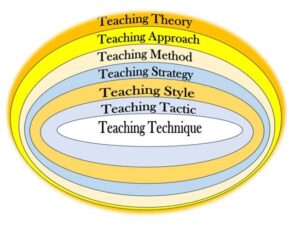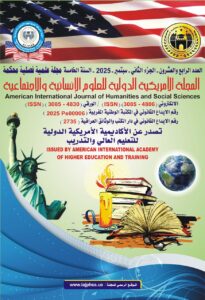
Iman Ghanim Shaban
Mosul Medical Technical Institute
Northern Technical University
imangh@ntu.edu.iq
009647702079559
Hussein Ali Ahmed
College of Languages
Nawroz University
Abstract
Teaching is the process of transmitting information from one party to another. In the process of teaching, the teacher has to be knowledgeable to make the class environment suitable for learners to learn the provided topic. The teaching process concentrates on three major components: teacher, students and subject matter. The teacher is usually the main figure in the class. He prepares the material to his students and presents it to them in the class. He also supplies them with feedback. In doing so, he uses different procedures. Those procedures have different terms that define them. Implementing various procedures requires setting objects, planning, selecting material, distributing the roles in the class, and so on.
This research aims to clarify the areas of overlap between these terms which are quite confusing for English language teachers and students and in such a way that will enable them to use the researched terms in their correct form and context. The researchers have reviewed some research that has overlaps in the meaning of some English language teaching-specific terms, namely- theory, approach, method, strategy, style, tactic, and technique. It is noteworthy that teaching theory attends to the process of defining and explaining the teaching process; a teaching approach: is the process of making assumptions about the teaching process; a teaching method: planning classroom procedures; a teaching strategy: fulfilling teaching objectives; a teaching style: finding out the best way to impart information; a teaching tactic: fulfilling short-term objectives and a teaching: implementing teaching methods while teaching. in the class. To bring about the research aims, the two researchers have set a criterion of three items viz goal, focus and hierarchy to estimate and find out the degree and extent of overlapping in the meanings of the terms already referred to by referring to the previous studies on the overlap between them. On analyzing the relevant data. It has been found out that overlap does exist between the meanings of these terms. Hence, some conclusions and recommendations have been forwarded.
Key Words: Overlap; ELT specific Terms; Teaching Approach; Teaching Style.
دراسة التداخل في معنى تدريس اللغة الإنجليزية – مصطلحات محددة
م.م. ايمان غانم شعبان
الجامعة التقنية الشمالية
جمهورية العراق
أ.د. حسين علي أحمد
جامعة نوروز
المستخلص
التعليم هو عملية نقل المعلومات من شخص إلى آخر. ويتكون من ثلاث مكونات رئيسية: المعلم والطلاب والموضوع. في عملية التعليم، يجب أن يكون المعلم على دراية بكيفية جعل البيئة الصفية مناسبة للمتعلمين لتعلم الموضوع المقدم. عادة ما يكون المعلم هو الشخصية الرئيسية في الفصل. يقوم بإعداد المادة لطلابه ويقدمها لهم في الفصل. كما أنه يزودهم بالتغذية الراجعة. وللقيام بذلك، يستخدم إجراءات مختلفة. ولهذه الإجراءات مصطلحات مختلفة تعبر عنها. يتطلب تنفيذ إجراءات مختلفة تحديد المادة والتخطيط واختيار المادة وتوزيع الأدوار داخل الفصل وما إلى ذلك.
ويهدف هذا البحث إلى توضيح مجالات التداخل بين هذه المصطلحات والتي تكون مربكة للغاية لمعلمي ومتعلمي اللغة الإنكليزية، وبما يمكنهم من استخدام المصطلحات في شكلها وسياقها الصحيح. قام الباحثان بمراجعة الدراسات التي تناولت مصطلحات محددة تستخدم في مجال تعليم اللغة الإنكليزية وتتمثل على نحو خاص بالنظرية، والنهج، والطريقة، والاستراتيجية، والأسلوب، والتقنية، والتكنيك.
ويهتم نهج التعليم بعملية وضع الافتراضات حول عملية التعليم؛ وتتعلق طريقة التعليم بتخطيط إجراءات الفصل الدراسي؛ واستراتيجية التعليم تهتم بتحقيق أهداف التعليم؛ ويهتم أسلوب التعليم بإيجاد أفضل طريقة لنقل المعلومات؛ ويهتم تكتيك التعليم بتحقيق الأهداف قصيرة المدى؛ ويهتم أسلوب التعليم بتطبيق طرق التعليم في الفصل.
وعلى هذا الأساس فقد وضع الباحثان معياراً من ثلاثة بنود وهي الهدف، ونقطة الاهتمام والتسلسل لتقدير ومعرفة درجة ومدى التداخل في معاني هذه المصطلحات. ويتم تحديد هذا المعيار بناء على الدراسات السابقة التي تناولت التداخل فيما بين هذه المصطلحات. واخيرا، تم استخلاص بعض النتائج وتقديم بعض التوصيات.
الكلمات المفتاحية: التداخل؛ الشروط الخاصة بتعليم اللغة الإنجليزية؛ نهج التدريس؛ أسلوب التدريس
Introduction
Teaching is the process of delivering information to students. Teaching does not connect to a specific place or people. However, it usually takes place in formal settings such as schools and universities. Those institutes are headed under the educational system. The three main categories in the educational system are teacher, learner and subject to teach. Teacher makes use of different teaching theories, approaches, methods, strategies, styles, tactics and techniques to impart the material to students.
Teaching theory originates from philosophy. Then, other disciplines have developed research in teaching theory concepts which are psychology and sociology (Jiang & Zhang, 2020). It is a conceptual framework which describes the process of how information is acquired, processed and then retained during the process of learning (Chaudhary, 2013). According to Chaudhary (2013), teaching theory accounts for three main questions: “How do teachers behave, why do they behave as they perform and with what effect”. It explains every aspect of teaching.
A further term to be considered is teaching approach which is less broad than a teaching theory and makes assumptions about how to teach a language. It is usually based on a theory. Also, a teaching method is sometimes mixed with a teaching approach. It is concerned with setting the class procedures, such as identifying the teacher and the student’s roles. Encyclopedia Britannica (1975) defines teaching methods as “various approaches to instruction consisting of both theories and their practical applications”. As such, it is evident that teaching methods have two different functions to do in the process of teaching. Teaching strategy is a further specific term. According to Encyclopedia Britannica (1975) the word strategy “strategos” is a Greek word which means “general”. The term teaching strategy has been borrowed from games theory (Foshay, 1975). In the educational field, it refers to the process of planning to achieve long-term goals of English language teaching. A teaching strategy is usually stable and does not change with a short time duration. Teaching style is used to refer to the best decision that a teacher can make to impart information to the students (Mosston & Ashworth, 2008). The research on teaching style is due to that in the domain of teaching method. Additionally, a teaching tactic is set to bring about short-term goals that a teacher tries to fulfil, usually within the time of the class. Finally, a teaching technique refers to the tools and ideas utilized by the teacher in the class to clarify the subject matter for the students.
Teachers use different ways to simplify subjects that they have to teach. In doing so, they adopt a teaching theory, approach, method, strategy, style, tactic and technique so as to make sure that their teaching is effective and efficient Richards & Rodgers, 2001). The consistency between these terms can make it easier for the teacher to explain the topic to the students and make them process and understand it better.
As far as researchers are concerned, no research, to the researchers’ best knowledge, has been conducted on all these terms as one package. There are no doubt research articles that have compared between two, three or four of these terms. For instance, Foshay (1975) compared teaching strategies and teaching tactics and Eslit (2023) also compared teaching approaches and teaching methods and both researchers stated that there was an overlap between the researched terms. Also, Hasanova et al. (2021) studied the difference and the relationship between teaching approaches, methods, procedures, techniques, styles and strategies on the basis of the definitions of these terms in dictionaries, represented mainly by Merriam Webster Dictionary and Oxford Advanced Learners Dictionary. They concluded that teaching approaches, methods, procedures, techniques, styles and strategies cannot be used interchangeably.
The second research is Kuamr (2022): the researcher has studied the terms teaching methods, strategies, techniques, and approach. This research investigates the differences and the relationships between the above-mentioned terms.It differs from Hasanova et al. (2021) in the number of terms. Kumar has chosen only four terms. Furthermore, he depends on dictionaries and previous studies to find out the differences and relationships between them. Finally, he ends up with the same conclusion of Hasanova et al. (2021) which is teaching methods, strategies, techniques, and approach terms cannot be used interchangeably.
Research Problem
It is noticed that there is incorrect use of the terms teaching theory, approach, method, strategy, style, tactic and technique in some related research works. What adds to the complexity of the issue is the interchangeable use of these terms by researchers whether in the title or within the body of the research works. Such wrong use and duly overlap between these terms becomes quite confusing for English language teachers and students and in such a way that will make it difficult to use the researched terms in their correct form and context.
Research Question
this research poses the following question:
- Does overlap take place in the meanings of the ELT-specific terms?
Research Aims
This research aims at
- defining the ELT-specific terms, namely teaching theory, approach, method, strategy, style, tactic and technique,
- reviewing the literature on ELT-specific terms with a focus on the overlap in meanings, and
- finding out the occurrence of overlap in their meanings.
Limits of the Research
This research is limited to seven English language teaching-specific terms, namely teaching theory, teaching approach, teaching method, teaching strategy, teaching style, teaching tactic and teaching technique.
Significance of the Research
The research is expected to be of some benefit to all those interested in subjects and topics pertinent to the process of teaching and learning English as it attempts to shed light and illustrate the vague and unclear meanings that are due to the overlap in the use of the following terms: teaching theory, approach, method, strategy, style, tactic and technique. It is also expected to motivate other researchers to further investigate the areas of overlap in the meanings of these terms in a more detailed and specified manner. Finally, English language teachers might benefit from the current research in their attempt to match these researched terms and in turn use them properly in their teaching.
Operational Definitions of Basic Terms
To define the set of researched terms operationally, it is important to state that they all refer to a number of terms that are used by people who are concerned with the issues related to the teaching-learning process. This is added to the fact that there is an elaboration on the definition of each term so as to highlight its specificity in the domain of English language teaching and as follows:
1. Teaching theory: is a set of ideas that explain teaching phenomenon.
2. Teaching approach: is a set of assumptions that direct teachers throughout the teaching process.
3. Teaching method: is setting classroom procedures that have to be followed during the teaching process.
4. Teaching strategy: is planning to fulfil long- term goals of the teaching process.
5. Teaching style: is finding out the best way of teaching.
6. Teaching tactic: is acting to fulfil long-term goals of the teaching process.
7. Teaching technique: is the process of implementing teaching theories, approaches, methods, strategies and styles in the class.
Methodology
The researchers have reviewed the resources that clarify and focus on the overlap between teaching theory, approach, method, strategy, style, tactic and technique. The resources that the researchers have considered for review are:
- Anthony (1963)2. The New Encyclopedia Britannica (1975)
- Foshay (1975)4. Richards & Rodgers (2001)
- Mosston & Ashworth (2008)6. Chaudhary (2013)
- Simovic et al., (2014) 8. Hasanova et al. (2021)
- Kumar (2022)10.Eslit (2023)
Findings
Depending on the resources reviewed, the researchers have set a criterion that comprises three items, viz. goal, focus and hierarchy (see Table: 1). Each item reveals and puts forward a side of overlap in meaning between the ELT-specific terms. Goal, for instance, identifies the general function of each term. Meanwhile, focus refers to whether the concentration is on actions or on setting rules to follow in the process of teaching. Finally, hierarchy indicates the level of broadness of each term, in comparison with the others.
Table (1) Criterion to overcome the Overlap
| Goal | Focus | Hierarchy | |
|
Teaching Theory |
Explaining teaching phenomenon | What/Why/how to teach | 1 |
|
Teaching Approach |
Making assumptions about teaching | How to teach | 2 |
| Teaching Method | Setting classroom procedures |
How to teach |
3 |
|
Teaching Strategy |
Planning to Fulfil long- term objectives | What to teach | 4 |
| Teaching Style | Finding the best way to impart knowledge |
How to teach |
5 |
|
Teaching Tactic |
Actions to fulfil short- term objectives | How to teach | 6 |
| Teaching Technique | Implementing teaching methods… |
How to teach |
7 |
Many resources which have an overlap in meaning between the specified English language teaching terms state that there is a hierarchal relation between them. However, the following figure is made to clarify the role of hierarchy.

Figure (1) Hierarchy of the Terms
Discussion of Findings
To answer the question raised in this research, the researchers have found out that teaching theory, approach, method, strategy, style, tactic and technique cannot be used alternately. This finding is in line with Hasanova et al. (2021) and Kuamr (2022). Because, as it obvious, each term has its own goal, focus and role to play in the hierarchical structure. The hierarchy figure is based on the definitions and stages of each term. For instance, teaching style is placed under teaching strategy depending on Simovic et al., (2014) definition of teaching style and Mosston & Ashworth’s (2008) spectrum of teaching style. However, each term works as a complement to the other. All the terms complete each other in a cyclic manner. As such, each term can be defined on the basis of the ones that precede it.
Conclusions
- Teaching theory, approach, method, strategy, style, tactic and technique cannot be used interchangeably.
- Certain terms can be used as an umbrella term that includes other terms.
- The suggested criterion can be used as a reference to clarify the meanings of the terms.
Recommendations
The researchers recommend the following:
- Teachers’ accurate and clear use of the researched terms can enable students to understand them correctly and avoid the overlap in their meanings.
- As the current research cannot be comprehensive in its coverage of the researched items, the researchers have left it open for other researchers to add other items to the criterion proposed in the current research.
References
- Anthony, E. M. (1963). Approach, method, and technique. elt Journal, 17(2), 63-67.
- Britannica, E. (1975). Encyclopedia Britannica.
- Chaudhary, A. (2013). Theories of teaching. International Journal for Research in Education (IJRE), 2(3).
- Eslit, E. R. (2023). Approaches and Methods Concept Paper Top Five Current Approaches and Methods in English Language Teaching. ResearchGate.
- Foshay, A. W. (1975). Teaching Tactics and Teaching Strategies. Educational Leadership, 32(6): 373-375.
- Hasanova, N., Abduazizov, B., &Khujakulov, R. (2021). The main differences between teaching approaches, methods, procedures, techniques, styles and strategies. JournalNX, 7(02), 371-375.
- Jiang, A. L., & Zhang, L. J. (2021). University Teachers’ Teaching Style and their Students’ Agentic Engagement in EFL Learning in China: A Self-Determination Theory and Achievement Goal Theory Integrated Perspective. Frontiers in Psychology, 12.
- Kuamr, A. (2022). Teaching Methods, Teaching Strategies, Teaching Techniques and Teaching Approach. IJARSCT, 2(2), 503-508.
- Rodgers, T. S. (2001). Approaches and Methods in Language Teaching.
- Simovic, T., Simovic, V., Milovic, L., &Balov, B. (2014). Students’ and Teachers’ Views on Teaching Styles and Methods. Bulgarian Comparative Education Society.









